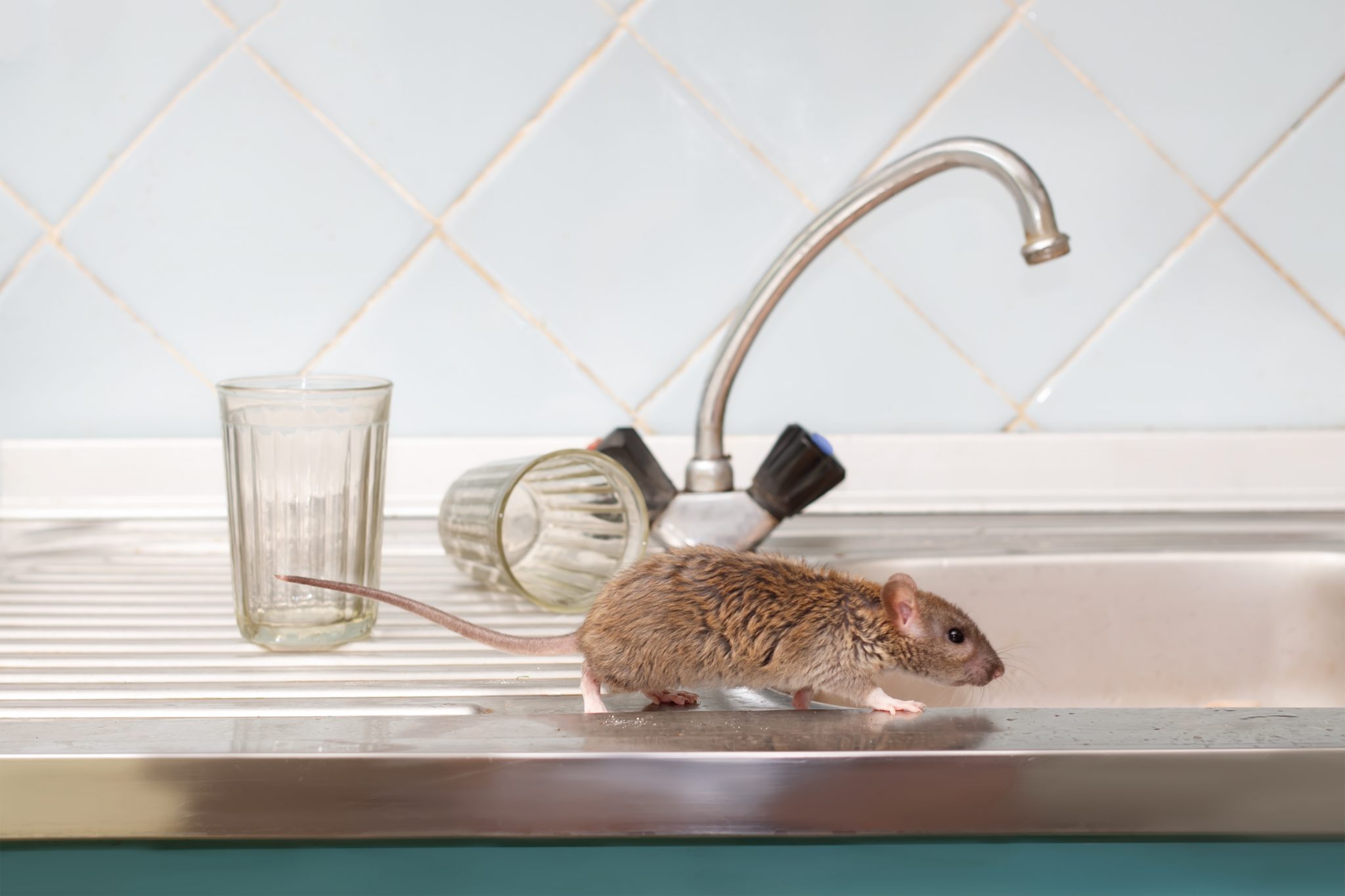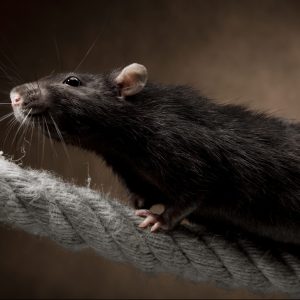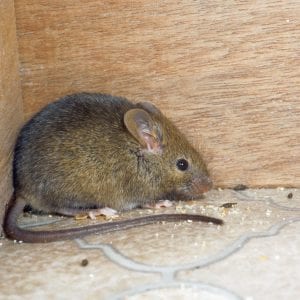Forestry & Wildlife

Rats and mice may cause harm to humans by transmitting diseases, destroying property, and biting. Understanding the three species of commensal rodents, Norway rat, roof rat, and house mouse, is important when determining the best management approach to eliminate this pest.
Norway rats, roof rats, and house mice are “commensal” rodents; that is, they live in close association with humans. Rats and mice may cause harm by transmitting disease, destroying property, and biting. While rats and mice may be an economic threat in agricultural settings, this publication focuses on controlling these rodents in and around buildings where people live.
Rats
Two species of rats are the most frequent offenders. Neither the Norway rat (Rattus norvegicus) nor the roof rat (Rattus rattus) are native to North America. They both arrived on boats from Europe along with the early settlers. While these introductions were not intentional, Norway rats and roof rats have established themselves as permanent residents.
An average adult Norway rat weighs about 1 pound. Its long, hairless tail is shorter than the head and body. Norway rats will nest under buildings and concrete slabs, along stream banks, and in garbage dumps. Often, they will burrow under the foundations of buildings and develop an elaborate burrow system with an entrance and several escape holes.
Although Norway rats can climb, they tend to inhabit the lower floors of multi-story buildings. In general, Norway rats are troublesome close to the ground, while roof rats inhabit the rafters. Roof rats are sometimes called black rats. As their name implies, roof rats are more aerial than Norway rats. They may be found in trees, vine-covered fences, or attics. They often enter buildings from the roof or from utility lines. Roof rats differ in appearance from Norway rats in that they are sleek, graceful, and generally not as large, and they have a pointed muzzle, larger ears, and a tail that is longer than the body.
Rats are usually nocturnal; however, as population densities increase they may be seen during daylight hours. They have an excellent sense of smell, taste, and touch.
Rat populations can expand rapidly. If unchecked, one pair can produce 6 to 12 young in 21 days. Sexual maturity is reached at 3 months. Therefore, assuming adequate food, water, and shelter, a single pair of rats may multiply into more than 640 rats in 1 year.
- Roof rat
- Norway rat
- House mouse
Mice
Like Norway rats and roof rats, the house mouse (Mus musculus) is not native to North America; it, too, arrived with the European settlers. House mice usually weigh less than 1 ounce and are grayish-brown in color. They are masters at gaining access to buildings and will chew, gnaw, climb, or swim to reach their destination.
House mice are primarily nocturnal. However, unlike Norway rats and roof rats, seeing mice during daylight hours does not necessarily indicate a high population.
House mice will eat just about anything, but they prefer grains and seeds. However, they eagerly consume foods high in fat, protein, or sugar. One characteristic that distinguishes them from Norway rats and roof rats is their ability to survive with little or no free water. They get the water they need from the foods they eat.
House mice shred paper, cloth, and other materials to make a ball-shaped nest. A litter of five to six young are born about 20 days after mating. These young are weaned in 3 weeks, and they are sexually mature at 6 to 10 weeks. A female may have five to ten litters per year. Thus in one year, a single pair of mice may multiply into several thousand.
Table 1. Characteristics of Commensal Rodents.
| Rodent | Feet | Head |
|---|---|---|
| Young rat | large | large |
| House mouse Mus musculus | small | small |
Table 2. Characteristics of Commensal Rodents.
| Rodent | Tail | Body | Ear | Eye | Nose |
|---|---|---|---|---|---|
Norway rat | shorter than head + body | heavy and thick | small | small | blunt |
Roof rat | longer than head + body | light and slender | large | large | pointed |
Rat and Mouse Control
Biological Control
Many types of wild and domestic animals may prey on rats and mice. Hawks, owls, and snakes will help keep rodent populations in check outdoors. While it is true that house cats may help reduce rat and mouse populations around the home, free-ranging house cats can have tremendous negative impacts on native wildlife such as songbirds. Biological control measures vary greatly in their effectiveness and are not reliable as a primary technique.
Rodent Proofing
Effective rodent control involves exclusion, sanitation, and chemical control. Wherever possible, buildings must be made rodent-proof. Rats and mice can climb wires, cables, vines, and trees to enter a house. They can climb the exterior siding of structures made of rough wood, concrete, or rough sheet metal. Rats may crawl along pipes up to 3 inches in diameter. The front teeth of rodents are not designed for gnawing hard, flat surfaces. However, if the surface is rough or has an edge to it, they can gnaw through most materials.
Rats have been known to gain entry into a structure through holes as small as 1⁄2 inch. Mice can enter through openings of 1⁄4 inch. Blocking possible entrance holes with secured sheet metal can help control rodent access to a building. Sheet metal cones or guards on pipes and cables may help prevent rats and mice from crawling or climbing to gain entry. Rat and mouse control is best achieved by combining exclusion techniques with a strong program of sanitation and poisoning.
Sanitation
Cleaning up around buildings can help control rat and mouse populations. Poor sanitation is one of the basic reasons for high populations of commensal rodents in urban and suburban areas. Pick up all garbage and litter, and store it in a rodent-proof container. In addition to removing possible sources of food, remove piles of trash or debris that could serve as cover.
Rodenticides
If proper exclusion techniques and a sound sanitation program are used, the need for rodenticides will be reduced. However, rodenticides may be useful in bringing a rodent problem under control or as a maintenance program to prevent rodent populations from becoming established. When considering a poisoning program, it is important to follow the manufacture label on the rodenticide. In addition, consider if any humans or non-target species will be able to access the rodenticide.
Before beginning a poisoning program, estimate the number of rats or mice present. The following criteria are useful in estimating the number of rats in an area.
No rats or a few present: No sign. If rats are present, there are only a few, and they may have only recently invaded.
Medium numbers present: Old droppings and gnawing common; one or more rats seen by flashlight at night; no rats seen in daytime.
Large numbers present: Fresh droppings, tracks, and gnawing. Three or more rats seen at night and rats seen in daytime.
Mice do not wander as far from the nest as rats. Thus a relative measure of mouse density may be obtained by sprinkling talc or flour at 20 to 30 foot intervals. The number of mouse tracks observed in these patches is a good indicator of how widespread the mouse problem may be.
Two broad categories of rodenticides are available: single-dose and multiple-dose. The single-dose, or acute, rodenticides are preferred where rat or mouse numbers are large and a quick reduction in population is desired. They also are useful where it may be difficult to get rats or mice to consume bait several days in succession.
Single-dose rodenticides are usually more effective with prebaiting. Rats and mice will get bait shy if they eat poison and get sick but do not die. Prebaiting, training rats or mice to feed on nontoxic baits at a bait station, before putting out poisons will allow the rats to get used to the new food source without associating it with sickness or death.
Multiple-dose, or chronic, rodenticides are mostly anticoagulants with a cumulative toxic effect. Death occurs about 4 or 5 days after the rodent first eats the bait. These do not produce bait shyness and are among the safest rodenticides. Because they act slowly, anticoagulant baits may serve as their own prebait.
Anticoagulants kill by inhibiting the clotting ability of the blood, so the animal dies of internal bleeding. Mice are generally less susceptible to anticoagulant baits than are rats.
Many different types and preparations of rodenticides are effective. Your specific situation dictates which one is best to use.
Rats and mice have poor eyesight and are essentially colorblind. Therefore, poison baits can be dyed for safety. Poison grains and pellets which have been dyed a bright color can easily be avoided by humans.
Bait Stations
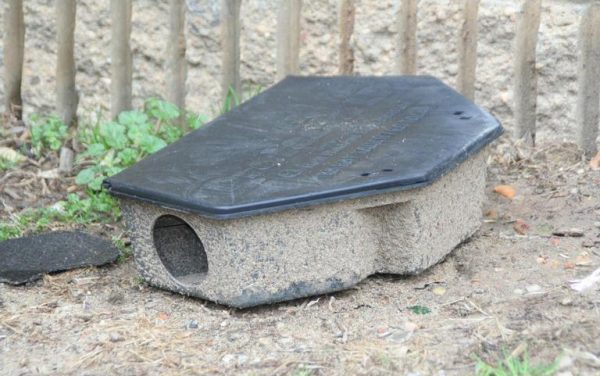
Liz Kasameyer, Johns Hopkins School of Public Health, Bugwood.org
Place rodenticides in bait stations to increase their effectiveness and safety. Bait stations protect bait from moisture, dust, and weather; provide a protected place for rodents to feed, allowing them to feel more secure; keep nontarget animals away from bait; and help prevent accidental spilling of bait. In addition, bait stations allow easy inspection of bait to determine use.
Bait stations do not have to be elaborate structures. They can be made by nailing flat boards at an angle to the wall. This provides a protected area between the board and the wall.
An 18-inch length of pipe (2 to 3 inch diameter) may be used as a bait station. A more elaborate design is a wooden box with a 2 1⁄2-inch hole in each end. The top of the box is hinged to allow inspection of the bait. Some of the rodenticides may be purchased in a commercially manufactured bait station.
Bait stations should be placed in areas of rodent activity. Placing the stations between the rodent’s shelter and food supply will increase exposure and use. Bait stations should be placed next to walls, as rats and mice normally use these areas as travel lanes.
Traps
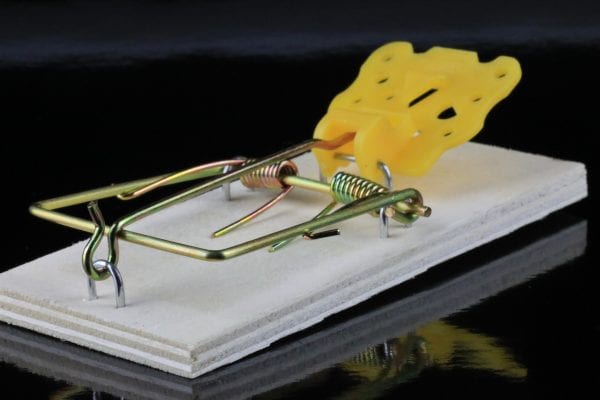 Traps are the best method of rodent control where poisons are unwanted or inadvisable. Common snap traps, glue boards, and live traps may all be effective if rat numbers are low. For roof rats, the traps should be placed along beams, rafters, or other travel ways. For Norway rats and house mice, traps should be placed under cabinets or next to a wall. Traps may be baited with a variety of food items; peanut butter makes a good bait that adheres to the trap trigger.
Traps are the best method of rodent control where poisons are unwanted or inadvisable. Common snap traps, glue boards, and live traps may all be effective if rat numbers are low. For roof rats, the traps should be placed along beams, rafters, or other travel ways. For Norway rats and house mice, traps should be placed under cabinets or next to a wall. Traps may be baited with a variety of food items; peanut butter makes a good bait that adheres to the trap trigger.
Summary
Controlling rats and mice in buildings involves a combination of exclusion, sanitation, and wise use of rodenticides. Wherever possible, rodents should be excluded by blocking or sealing all areas where they may enter the building. A judicious program of sanitation will help control rat populations before they increase. Rodenticides may be used to bring problem rat populations into check.
However, poisons alone will not provide long-term relief from rat infestations. Rodenticides must be used along with exclusion and sanitation efforts. Trapping may be effective where rat or mouse populations are low. When disposing carcasses, it is important to wear gloves and to wash hands afterwards.
Download a PDF of Controlling Rats and Mice Around Your Home, ANR-0688.

